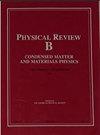Molecular dynamics study on magnesium hydride nanoclusters with machine-learning interatomic potential
IF 3.7
2区 物理与天体物理
Q2 MATERIALS SCIENCE, MULTIDISCIPLINARY
引用次数: 3
Abstract
We introduce a machine-learning (ML) interatomic potential for Mg-H system based on Behler-Parrinello approach. In order to fit the complex bonding conditions in the cluster structure, we combine multiple sampling strategies to obtain training samples that contain a variety of local atomic environments. First-principles calculations based on density functional theory (DFT) are employed to get reference energies and forces for training the ML potential. For the calculation of bulk properties, phonon dispersion, gas-phase ${\mathrm{H}}_{2}$ interactions, and the potential energy surface (PES) for ${\mathrm{H}}_{2}$ dissociative adsorption on Mg(0001) surfaces, our ML potential has reached DFT accuracy at the level of GGA-PBE, and can be extended by combining the DFT-D3 method to describe van der Waals interaction. Moreover, through molecular dynamics (MD) simulations based on the ML potential, we find that for ${\mathrm{Mg}}_{n}{\mathrm{H}}_{m}$ clusters, $\mathrm{Mg}/\mathrm{Mg}{\mathrm{H}}_{x}$ phase separation occurs when $ml2n$, and for a cluster with a diameter of about 4 nm, the Mg part of the cluster forms a hexagonal close-packed (hcp) nanocrystalline structure at low temperature. Also, the calculated diffusion coefficients reproduce the experimental values and confirm an Arrhenius type temperature dependence in the range of 400 to 700 K.具有机器学习原子间势的氢化镁纳米团簇分子动力学研究
我们介绍了一种基于Behler-Parrinello方法的Mg-H系统的机器学习(ML)原子间势。为了适应簇结构中复杂的键合条件,我们结合了多种采样策略来获得包含多种局部原子环境的训练样本。基于密度泛函理论(DFT)的第一性原理计算得到用于训练机器学习电位的参考能量和力。对于体性质、声子色散、气相${\ mathm {H}}_{2}$相互作用以及${\ mathm {H}}_{2}$在Mg(0001)表面解离吸附的势能面(PES)的计算,我们的ML势已经达到了GGA-PBE水平的DFT精度,并且可以通过结合DFT- d3方法来扩展描述范德华相互作用。此外,通过基于ML势的分子动力学(MD)模拟,我们发现对于${\mathrm{Mg}}_{n}}{\mathrm{H}}_{m}$团簇,$\mathrm{Mg}/ $ mathrm{Mg}} {\mathrm{H}}_{x}$在$ml2n$时发生相分离,对于直径约为4 nm的团簇,Mg部分在低温下形成六方密排(hcp)纳米晶体结构。计算得到的扩散系数与实验值吻合,在400 ~ 700 K范围内具有Arrhenius型的温度依赖关系。
本文章由计算机程序翻译,如有差异,请以英文原文为准。
求助全文
约1分钟内获得全文
求助全文
来源期刊

Physical Review B
PHYSICS, CONDENSED MATTER-
CiteScore
6.30
自引率
32.40%
发文量
4177
期刊介绍:
Physical Review B (PRB) is the world’s largest dedicated physics journal, publishing approximately 100 new, high-quality papers each week. The most highly cited journal in condensed matter physics, PRB provides outstanding depth and breadth of coverage, combined with unrivaled context and background for ongoing research by scientists worldwide.
PRB covers the full range of condensed matter, materials physics, and related subfields, including:
-Structure and phase transitions
-Ferroelectrics and multiferroics
-Disordered systems and alloys
-Magnetism
-Superconductivity
-Electronic structure, photonics, and metamaterials
-Semiconductors and mesoscopic systems
-Surfaces, nanoscience, and two-dimensional materials
-Topological states of matter
 求助内容:
求助内容: 应助结果提醒方式:
应助结果提醒方式:


